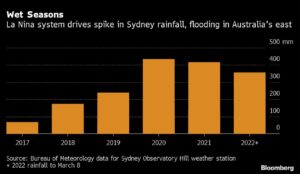Tens of thousands of residents from Sydney and Brisbane and nearby regional areas have been forced to flee their homes as extreme rainfall and persistent flooding wreaked havoc across Australia’s east coast.
Prime Minister Scott Morrison is expected to formally declare a national emergency on Wednesday, as he visits one of the worst affected areas, handing the government more powers to deploy aid and defense force personnel. The floods on Tuesday left hordes of commuters stranded around Australia’s most populous city, Sydney, just as the central business district was starting to come back to life after the lifting of Covid-19 restrictions.
Two La Nina seasons in 2021 and 2022 have led to unusually wet summers on Australia’s east coast, and put climate change in focus ahead of a national election due to be held by the end of May. The Prime Minister has committed to net zero carbon emissions by 2050, but his government has been regularly criticized for taking inadequate action on climate change.
 In a statement on Monday, Australia’s Climate Council advocacy group said scientists had been warning “for decades” of the dangers from extreme weather caused by carbon emissions.
In a statement on Monday, Australia’s Climate Council advocacy group said scientists had been warning “for decades” of the dangers from extreme weather caused by carbon emissions.
“Climate change isn’t a footnote to the story of these floods. It is the story,” the council said in the statement.
Residents in parts of New South Wales state, including in greater Sydney’s wealthy northern beaches suburbs, were forced to evacuate on Tuesday afternoon as roads were cut off and amid concern about a dam overflowing. The flooding has already claimed at least 20 lives across Queensland state and New South Wales since the downpours began about two weeks ago.
There have been almost 100,000 claims to insurers as a result of the floods in NSW and Queensland, according to the Insurance Council of Australia, 80% of which were for domestic property. In NSW, there has been an increase of 12% in the past 24 hours. The estimated current cost of claims is now AUD$1.45 billion ($1.1 billion), the council said, based on the numbers from previous flood events.
The floods, combined with Russia’s invasion of Ukraine, led Australia’s consumer sentiment to plunge in March, falling 4.2% to 96.6 point according to Westpac Banking Corp., the weakest result since September 2020.
Australia is considered by many to be at vanguard of the impact of climate change — a position that’s become frighteningly clear in recent years. Torrential flooding episodes during wet years have been interspersed with blazing dry summers that have led to devastating wildfires, including the 2020 crisis that scorched an area of land almost the size of England.
Morrison has pledged to cut Australia’s emissions by up to 28% by 2030, but an Essential poll in November 2021 found Australians trusted the opposition Labor Party more to handle the issue of climate change than the government, by a margin of 39% to 26%.
Higher prices for food and bare supermarket shelves are set to become more frequent occurrences in Australia, as an increasingly volatile climate threatens supply chains and the availability of vital inputs including insurance, finance and fertilizer, according to a Wednesday report from environmental lobby group Farmers for Climate Action.
Was this article valuable?
Here are more articles you may enjoy.

 OpenAI And Microsoft Sued Over Murder-Suicide Blamed on ChatGPT
OpenAI And Microsoft Sued Over Murder-Suicide Blamed on ChatGPT  Musk’s xAI Faces California AG Probe Over Grok Sexual Images
Musk’s xAI Faces California AG Probe Over Grok Sexual Images  First Brands Judge Approves Examiner to Probe Fraud Allegations
First Brands Judge Approves Examiner to Probe Fraud Allegations  JPMorgan Wins Gender Pay Gap Dispute Against London Analyst
JPMorgan Wins Gender Pay Gap Dispute Against London Analyst 